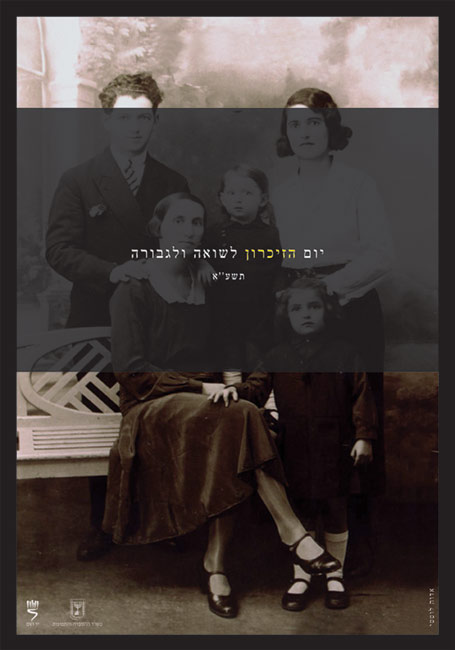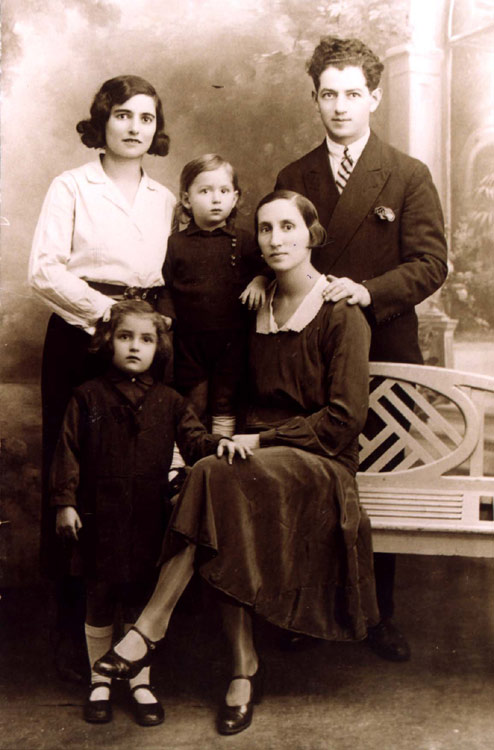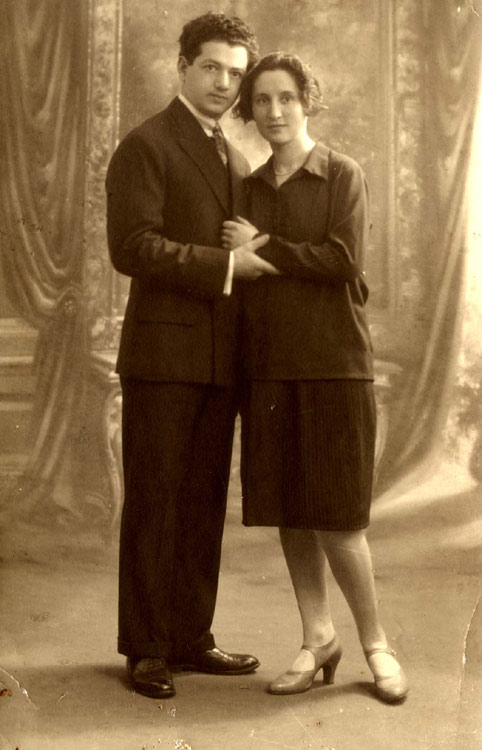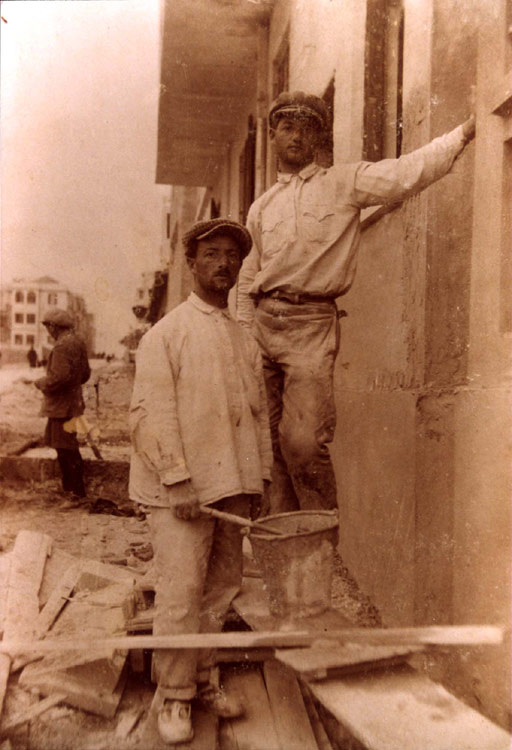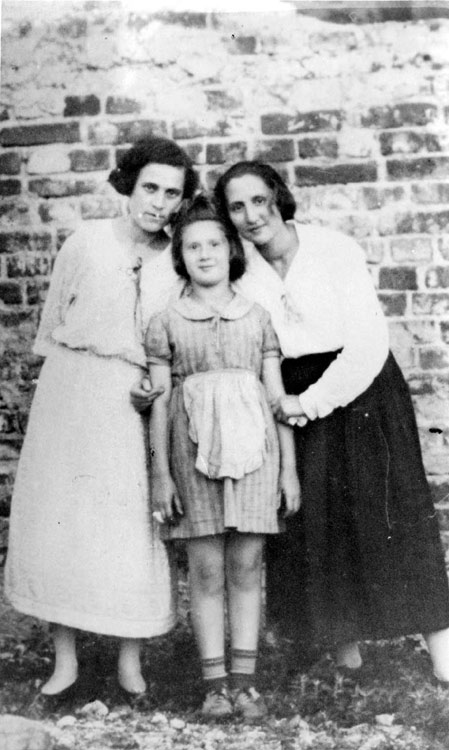Grades: Middle and High School
Duration: 1.5 hours
Opening
This lesson plan focuses on the winning design of this year's national competition to create a poster to mark Israel's Holocaust Martyrs' and Heroes' Remembrance Day held by Yad Vashem and the Israel Ministry of Public Diplomacy and Diaspora Affairs (5751/2011). This poster, designed by Open University student Adva Loutaty, was chosen from 180 competition entries.
According to the judges, the winning poster was chosen because it was "… a well-designed poster, requiring effort to decipher and internalize. The key question it deals with is the fact that memory tends to fade…. This is expressed in the intentional blurring of the dramatic areas of the picture. The disturbing and significant concealment of the peoples' faces creates a dialogue with the death-notice style of the poster's frame, which emphasizes the message even more strongly."
Rationale
This lesson plan will discuss the meaning of the term "remembrance" in light of the idea expressed in the poster, which uniquely engages this year's theme for Holocaust Remembrance Day: "Fragments of Memory." During the lesson, discussion points and educational activities will be presented to further illuminate the topic of remembrance in all its complexities.
The pupils will be shown the poster in order to encourage a class discussion of Holocaust remembrance with an emphasis on this year's chosen theme: "Fragments of Memory: The Faces Behind the Documents, Artifacts, and Photographs." The artifact or photograph, as opposed to the written word, has the power to illustrate a figure, and bring it to life before our eyes. The faces of people, their clothes and their personal belongings endear us to them. We wish to encourage this closeness, and create empathy on behalf of the students towards the victims. To this end, we will use the poster's image of a family, faces and people who are very similar to us, despite having lived at a different time and having had a different fate.
Introduction
Sixty-six years have passed since the end of World War II, and the Holocaust continues to stand at the center of Jewish and universal dialogue in a range of historical, humanistic and value-based contexts. Holocaust Martyrs' and Heroes' Remembrance Day is when the State of Israel honors the memory of the six million Jews murdered by the Nazis and their accomplices during the Shoah. It is a day of personal and collective remembrance, a day of commemorating the victims, empathyzing with the survivors, and alerting the world to the dangers of antisemitism and xenophobia. Each year, we mark Holocaust Remembrance Day through official events, in the educational system, through the press, and with a large variety of local and nationwide ceremonies.
One of the most important and productive ways to deal with the Shoah is through art. Works of art have the power to present reality through the expansion of our own horizons of comprehension. Exposure to art also allows us to delve into universal questions concerning the personal life of the individual.
Lesson Development
- What do you see in the poster?
The students' answers will form the basis of the continued dialogue, whether they relate to the more simplistic features of the poster – the photograph, a family, a black band – or whether they bring up more complex thoughts and ideas.
Analyzing the Poster – Suggestion
The poster is composed of a black frame surrounding a photograph of a Jewish family that lived in Europe before the Holocaust. The center of the photograph is covered with a wide black band, which veils the faces of the family members. Only through a concerted effort on the part of the observer are the features of the people in the picture revealed. The words "Holocaust Martyrs' and Heroes' Remembrance Day" are printed in the center of the poster, with the word "remembrance" highlighted in yellow.
The Structure of the Poster
Before we discuss the details of the poster before us, let us try to understand its entire structure as a complete, designed piece. First, the poster has a wide, black frame, similar to the type used for death notices, with the text (or in our case, a family photograph) in the center – representing the people (or in our case, as we will see later, some of them) whom we are mourning.
The text in the center of the poster – Holocaust Martyrs' and Heroes' Remembrance Day – places the topic of commemorating the victims of the Holocaust, their existence and their legacy, at the core of our consciousness.
As an opening question, you could ask the group:
- What is the role of artifacts, documents and photographs in our commemoration of those killed during the Holocaust?
- What is the meaning of these "agents of memory"? Which void do they fill for us?
- How does the use of a death notice template contribute to the message of the poster?
- What is "remembrance"? Can we remember only those things that we ourselves have experienced? Are we able to build into our own consciousness the memory of the existence and the lives of those killed during the Shoah?
The Concealment – the Black Band
The poster presents us with an obscured photograph, whose very concealment is the most obvious message – the observer must seek out the picture behind the black band. But first, we must deal with the meaning of the band itself.
- Why do you think there is a black band across the photograph?
- How does this concealment affect us, the observers?
It would seem, in the simplest and most obvious manner, that the black band represents the physical murder of most of the people in the photograph. During World War II, the Nazis murdered six million Jews across Europe. A whole world was wiped out in the Shoah, leaving very little for us to remember it by.
Most tragic of all, their obliteration created a rift between us and them, wherein we know very little, if anything, about their lives. Studying the Holocaust – the murders – has a natural outcome: we remember the victims as bodies, as formless, tormented hordes, and not as ordinary people who lived within a rich and vibrant Jewish world. Besides the murder, therefore, the black band represents our distancing from the existence of these people, and how little we know of them and their lives (cultural, daily, ideological, etc.) – a distancing born both of the killings and of the passage of time, which blurs and dulls memory.
The photograph in the poster is surrounded by a black band, reminiscent of a death notice: this notifies us of the deceased, but it also conceals the faces of the Jewish family depicted, which drives us to want to see them more clearly, to find out who they were – so we can know who and what we are mourning.
We therefore have a role in the task of remembrance – to rescue the attributes of the murdered.
To achieve this, we must make great efforts to reveal that which is concealed, blurred – and uncover an obliterated world.
Revealed – What is Hidden Behind the Black Band?
- What do you now see revealed from behind the black band?
- How would you have previously described a Jewish family from before the Holocaust?
For many reasons, we tend to think of Holocaust victims as very different from us, far from our daily experience. The place, time and lifestyle they were part of all create an estrangement from us, leaving our consciousness more focused on how we differ, rather than how similar we actually are.
Many people, for example, characterize prewar Jewry as living in small villages and towns, as Jews had done for hundreds of years before the 20th century. The Jewish communities in these towns were defined in a particular way – similar to the image of the families in Fiddler on the Roof – rabbis, students, religious slaughterers, circumcisers and assorted workers such as shoemakers and milkmen – a world very different to the one we live in today.
Yet here, behind the black band, we reveal a modern Jewish family, different perhaps to what we had imagined. The picture does not create distances or disparities, rather resemblances and similarities. People like us: parents, children, families. The simple things we have in common reveal the people previously obscured to us by time and location.
The photograph is of the Yoffe family, who lived in Paris before the war. The father of the family, Hershel Joffe, made a living selling leather handbags. He married Gittel Rabinovitz at the end of the 1920s. We see their children as well – Rachel-Roza and Abremele, as well as an aunt. We know that both Hershel and Gittel visited Eretz Israel in the 1920s. In one photograph Hershel appears as a builder in Tel Aviv.
Actually, this is all we know about the family. But we can still imagine what people and families like them would have hoped and dreamed of during their lives. What would the couple have wished for themselves? How did they see their future? What kind of future did they want for their children?
The European Jewish world was, therefore, extremely varied, and similar to our own lives in many ways. The Yoffe family shown in the poster provides us with a window on this diverse Jewish world, as well as a more solid base on which we can mourn during Holocaust Martyrs' and Heroes' Remembrance Day, a motif made clear by the death-notice structure of the poster.
The Interpretation – How Does Remembrance Appear Now?
In the photograph concealed behind the black band, the family represents a whole world that was but is no longer, and the meaning of remembrance changes.
- What does Holocaust Martyrs' and Heroes' Remembrance Day mean to us now?
- Why do you think the word "remembrance" is highlighted in yellow?
After we have lifted the black band across the poster and revealed the people and their world behind it – they are already seared into our hearts, because of the process we have made in deciphering the poster, and understanding the renewed meaning of Holocaust Martyrs' and Heroes' Remembrance Day. No longer are the murders themselves the center of our mourning, but instead there now exists a real, concrete grief for the people, the families and the communities that once existed and are no longer. This is a bereavement with content, and thus with deep meaning. The black band may not have been actually removed – for six million Jews were killed and are no longer with us – but it can certainly illuminate us further if we make an effort to relate to the deeper aspects of remembrance and empathy.
Suggested Activity to Conclude the Lesson – Collecting and Displaying Fragments of Memory
- Suggestion 1
Each group of students should choose a person who appears on a Page of Testimony from those attached to this lesson plan. The personal details listed about these people are minimal.
First, the group should try to write about the possible life of their chosen person – what a person of that age would possess, what s/he would be thinking about, what s/he would be hoping for.
Next, the group should try to fill in the gaps on the Pages of Testimony by expanding the given information. For example, if the name of the town that the person's family came from is listed, the group should find all possible information about that town on the Internet or in their school library. The same should be done for all other personal details on the Page.
At the end of the process, the group should present the "research" they carried out in front of the whole class.
- Suggestion 2
Each student should be asked to find an artifact, photograph or document from the Yad Vashem databases and perform basic research about it. They should find out who it belonged to, and what it meant to them (how it was used, and whether there is an interesting story to its existence) – as well as its meaning to us today.




